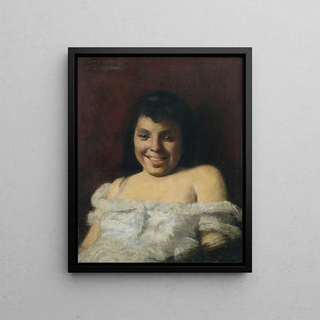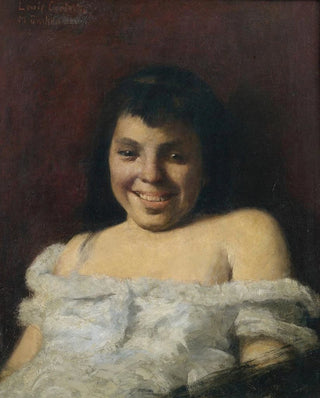Art print | Girl Laughing - Lovis Corinth Source: Reproduction | Fille qui rit - Lovis Corinth


View from behind

Frame (optional)
In the fascinating world of art, some works manage to capture the very essence of human emotion. "Fille qui rit" by Lovis Corinth is a shining example. This canvas, vibrant with life, immerses us in a fleeting moment of pure joy, revealing art's ability to transcend time and space. The artist, through his bold style and refined technique, succeeds in immortalizing a smile, a spark of innocence and happiness that resonates deeply within us. This piece, light and airy, invites us to explore the nuances of human expression while offering a window into the soul of its model.
Style and uniqueness of the work
Lovis Corinth, an emblematic figure of the expressionist movement, stands out with his rich palette and dynamic brushstrokes. In "Fille qui rit," he uses luminous hues and striking contrasts to bring his subject to life. The softness of the lines, combined with the vibrancy of the colors, creates a visual harmony that draws the eye and captivates the mind. The composition is marked by a spontaneity that feels almost photographic, as if the artist had succeeded in capturing a fleeting moment of happiness. This painting does not merely depict a smiling young girl; it evokes an atmosphere of lightness and freedom, a celebration of childhood joy. Corinth's technique, blending impressionism and expressionism, allows us to feel the texture of the skin and the sparkle of the eyes, making the work almost tactile.
The artist and his influence
Born in 1858 in Tapiau, in East Prussia, Lovis Corinth established himself as a master of painting at the turn of the 20th century. His career, characterized by a constant stylistic evolution, reflects his desire to push the boundaries of traditional art. Corinth was influenced by masters such as Rembrandt and Van Gogh, but he also incorporated elements of modernity unique to him. His bold approach and exploration of human emotions profoundly marked his contemporaries and paved the way for new forms of artistic expression. By highlighting the human subject in all its complexity

Matte finish

View from behind

Frame (optional)
In the fascinating world of art, some works manage to capture the very essence of human emotion. "Fille qui rit" by Lovis Corinth is a shining example. This canvas, vibrant with life, immerses us in a fleeting moment of pure joy, revealing art's ability to transcend time and space. The artist, through his bold style and refined technique, succeeds in immortalizing a smile, a spark of innocence and happiness that resonates deeply within us. This piece, light and airy, invites us to explore the nuances of human expression while offering a window into the soul of its model.
Style and uniqueness of the work
Lovis Corinth, an emblematic figure of the expressionist movement, stands out with his rich palette and dynamic brushstrokes. In "Fille qui rit," he uses luminous hues and striking contrasts to bring his subject to life. The softness of the lines, combined with the vibrancy of the colors, creates a visual harmony that draws the eye and captivates the mind. The composition is marked by a spontaneity that feels almost photographic, as if the artist had succeeded in capturing a fleeting moment of happiness. This painting does not merely depict a smiling young girl; it evokes an atmosphere of lightness and freedom, a celebration of childhood joy. Corinth's technique, blending impressionism and expressionism, allows us to feel the texture of the skin and the sparkle of the eyes, making the work almost tactile.
The artist and his influence
Born in 1858 in Tapiau, in East Prussia, Lovis Corinth established himself as a master of painting at the turn of the 20th century. His career, characterized by a constant stylistic evolution, reflects his desire to push the boundaries of traditional art. Corinth was influenced by masters such as Rembrandt and Van Gogh, but he also incorporated elements of modernity unique to him. His bold approach and exploration of human emotions profoundly marked his contemporaries and paved the way for new forms of artistic expression. By highlighting the human subject in all its complexity






